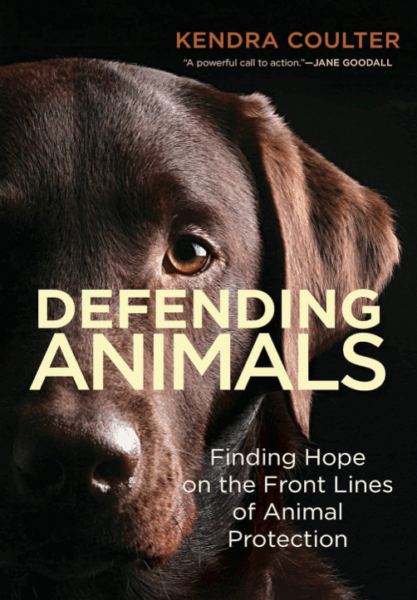During the writing of Defending Animals: Finding Hope on the Front Lines of Animal Protection, Kendra Coulter’s dog, Sunny, spent many hours wrapped around her feet. Sunny, who had been abused and starved for the first year of her life, has found love with Coulter and her family—and she is one of the many examples of why, as Coulter writes, “animal protection is an urgent social issue with life-and-death implications … We cannot cultivate free, caring, and humane societies in soil poisoned by suffering.” Coulter dedicates the book to “the animals we have saved, those we have failed, and those whose fates are still in our hands.”
Defending Animals tells the stories of the humans who dedicate their lives to helping animals, including (but not limited to) police and animal control officers, nonprofit volunteers, veterinarians, academics, and many more. For the past ten years, Kendra Coulter has consulted and interviewed more than sixty investigators, veterinarians, lawyers, researchers, conservationists, policy makers, advocates, care providers, and more. She has followed animal welfare officers on the job, gone to professional and academic conferences, and visited farm sanctuaries. And while this is a book about animals, it’s also about humans and our society because “in homes where animals are in danger or are being abused, people are often also at risk.” Likewise, human vulnerability and wildlife protection are often connected: “Conservation work near some of the poorest communities in the world, including those with armed conflicts, augments the stakes for people and animals alike.” And of course, animal agriculture causes some of the worst harm of all for both human and nonhuman animals: “For more than a decade, the United Nations and other leading scientists have recognized that factory farming is a major contributor to climate change. And as fires, floods, and extreme weather worsen as a result of the changing climate, it is already disadvantaged people the world over who will suffer the most.”
As Coulter makes clear in her introduction, understanding this interconnectedness is crucial to doing better for animals. She also makes clear that this means paying attention to language, particularly by not referring to nonhuman animals as it—a seemingly small detail but an important one when it comes to believing nonhumans deserve protection from both legal and illegal cruelty.
And she shows how connecting these dots can make a real difference. In just one example, in 2017 detective Vanessa Acosta of El Paso, Texas, founded the nonprofit Law N Paws to help provide care and housing for animals from cruelty cases, including veterinary care, spay/neuter, vaccines and microchips, and adoption—this came after a difficult cruelty case after which Acosta realized how few resources the police had for animal cases. Acosta “began digging into the criminological and forensic psychology research about people who abuse animals, including the fact that violent offenders often begin with animals before moving onto human victims” and when she shared her findings with the police chief, he moved to create the Animal Cruelty Investigations Unit, which had six detectives by 2021. Protecting animals protects people—as Coulter writes, “crimes against animals are not a distraction from community safety. They are integral to it”—and better human services in turn help animals. Defending Animals shows how, in just about every circumstance, human lives and animal lives are intertwined, and how protecting people from poverty and from being unhoused helps protect animals.
Coulter takes us behind the scenes and highlights government and nonprofit work in the U.S., Canada, and other countries, noting how laws differ geographically. In Germany, for example, “rigorous daily exercise for dogs is legally mandated.” In the U.S., animals are defined as property in legal terms—yet the FBI classifies animal cruelty as a crime against society, not property. In 2011, the Netherlands created a dedicated animals branch within its national police services. Colombia’s national laws prohibit animal fighting, the use of wild animals in circuses, and the hunting of wildlife. And many countries, including Spain, France, Sweden, Britian, and New Zealand, legally recognize animals as sentient beings.
Along the way, Coulter highlights myriad organizations who are doing incredibly good work—far too many to list in this review but all of which are making a real difference for animals around the world. Beyond Fences builds fences to help prevent dogs from being chained in unfenced yards. Pets for Life helps low-income people care for their animals, and My Dog Is My Home helps remove barriers for people to find shelter and housing for themselves and their companion animals. City Wildlife helps rehabilitate injured animals in Washington, D.C., as well as leads efforts to track and combat fatal bird-glass strikes in the region, and the Primate Rescue Center in rural Kentucky provides sanctuary for rescued monkeys and apes, freeing them from human demands such as medical research and entertainment.
In cases of the abuse of companion animals, Coulter looks at the difference between neglect and cruelty, and the nuances within. Some animals are neglected out of ignorance or indifference; sometimes their humans have challenges that don’t allow them to care for their animals as well as they’d like. Likewise, investigations and punishments for animal abuse are far more complex than they may seem; humans abuse nonhuman animals for no singular reason, and while “more than thirty US states either recommend or require judges to include treatment and counseling programs as part of animal cruelty sentences,” even with these programs, not all treatments fit the crimes.
When it comes to the conservation of wild animals, Coulter notes that it’s important to find a balance between protecting animals and respecting indigenous cultures, as well as to acknowledge that poaching is sometimes an act of greed but often an act by people who have few economic options. “On the ground, important conservation strategies involve creating human jobs—alternative options for people to earn a living not by harming animals but by helping them.”
And for those who want to help wild animals in our own neighborhoods, it can be incredibly challenging to find help for such injured animals as racoons, skunks, squirrels, and birds, with veterinarians unable to treat wild animals and wildlife rescue and rehab organizations overwhelmed. Captive wild animals are a whole other story, and have a dedicated chapter in the book that is insightful and important; the often unknown abuse and neglect of horses is the focus of another chapter. And for those seeking to make a real difference in the lives of animals, the most important chapter is probably the last one, which focuses on farm animals. The horrific abuses done to farmed animals are tempered by profiles of the VINE Sanctuary in Vermont, the Texas cattle ranch that became the Rowdy Girl Sanctuary, Farm Sanctuary, and many others that offer information, education, and compassionate options (i.e., being vegan) to avoid the unnecessary slaughter of billions of animals (more than 10 billion in the U.S. alone)—not including aquatic animals—raised for food. Eating plants instead of animals is the one thing any and every human can do to help animals—as well as the planet and other humans. “Factory farming means manure lagoons that poison ground water, air pollution, and significant greenhouse gas emissions.” Slaughterhouses “are disproportionately staffed by local people without other options, and migrant or temporary workers from other countries…The work is exhausting, physically dangerous, especially with larger, terrified animals like cows, pigs, and horses, and fodder for nightmares and worse.”
Ironically, many who do incredible work in certain areas of rescue do not extend their efforts to all animals. “I have sat with animal cruelty investigators in their field while they ate sandwiches made from animals who suffered as much, if not more, than the animals those officers work tirelessly to defend every day,” Coulter writes. “Some animal rescues host fundraisers to generate money to help some animals, such as dogs or cats or even horses, while serving the flesh of others.”
Yet some of the humans in rescue do see the broader picture. “On the other hand,” Coulter writes, “I have sat with officers, including from police services, who express concern for animals on farms, and as a result, are vegetarians or vegans. These dynamics are far from tidy, even within the spheres of animal protection.”
In an inspiring look at what Coulter calls “the business of animal protection,” she notes that many companies are creating alternatives to practices that harm animals. “Many vegan companies are being propelled not only by an ethical commitment to animals but also by a broader set of priorities, including environmental sustainability and human well-being,” which includes fair trade, organic products, diverse workplaces, and more.
Defending Animals is essential reading for anyone who cares about animals, not only for getting a firsthand look at how dedicated humans are doing their best to help animals but for how to be a part of the solution as a whole. What’s clear in these stories is that despite the toll it takes, so many compassionate humans keep showing up for animals—and we all need to be part of the change. Defending Animals offers readers and animal lovers an opportunity to learn more about the animals, the humans, and the issues, as well as to do their part in whatever way they can, from not eating or wearing animals to stepping up in their own communities. Dorothea Stevens, a public health nurse who volunteers in her Apache nation in southern Arizona, sums it up well: “Adopt. If you can’t adopt, foster. If you can’t foster, sponsor. If you can’t sponsor, volunteer. If you can’t volunteer, donate. If you can’t donate, educate.”

Midge Raymond is a co-founder of Ashland Creek Press. She is the author of the novels Floreana and My Last Continent, the award-winning short story collection Forgetting English, and, with John Yunker, the suspense novel Devils Island.

